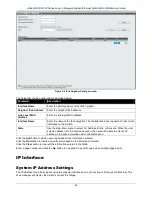
xStack® DGS-3120 Series Layer 3 Managed Gigabit Ethernet Switch Web UI Reference Guide
34
Figure 2-35 Switches stacked in a Duplex Chain
Figure 2-36 Switches stacked in a Duplex Ring
Within each of these topologies, each switch plays a role in the Switch stack. These roles can be set by the user
per individual Switch, or if desired, can be automatically determined by the Switch stack. Three possible roles exist
when stacking with the Switch.
Primary Master
– The Primary Master is the leader of the stack. It will maintain normal operations, monitor
operations and the running topology of the Stack. This switch will also assign Stack Unit IDs, synchronize
configurations and transmit commands to remaining switches in the switch stack. The Primary Master can be
manually set by assigning this Switch the highest priority (a lower number denotes a higher priority) before
physically assembling the stack, or it can be determined automatically by the stack through an election process
which determines the lowest MAC address and then will assign that switch as the Primary Master, if all priorities
are the same. The Primary master are physically displayed by the seven segment LED to the far right on the front
panel of the switch where this LED will flash between its given Box ID and ‘H’.
Backup Master
– The Backup Master is the backup to the Primary Master, and will take over the functions of the
Primary Master if the Primary Master fails or is removed from the Stack. It also monitors the status of neighboring
switches in the stack, will perform commands assigned to it by the Primary Master and will monitor the running
status of the Primary Master. The Backup Master can be set by the user by assigning this Switch the second
highest priority before physically assembling the stack, or it can be determined automatically by the stack through
an election process which determines the second lowest MAC address and then will assign that switch as the
Backup Master, if all priorities are the same. The Backup master are physically displayed by the seven segment
LED to the far right on the front panel of the switch where this LED will flash between its given Box ID and ‘h’.
Slave
– Slave switches constitute the rest of the switch stack and although not Primary or Backup Masters, they
can be placed into these roles when these other two roles fail or are removed from the stack. Slave switches
perform operations requested by the master, monitor the status of neighbor switches in the stack and the stack
topology and adhere to the Backup Master’s commands once it becomes a Primary Master. Slave switches will do
a self-check to determine if it is to become the Backup Master if the Backup Master is promoted to the Primary
Master, or if the Backup Master fails or is removed from the switch stack. If both Primary and Backup masters fail,
or are removed from the Switch stack, it will determine if it is to become the Primary Master. These roles will be
determined, first by priority and if the priority is the same, the lowest MAC address.
Once switches have been assembled in the topology desired by the user and powered on, the stack will undergo
three processes until it reaches a functioning state.
Initialization State
– This is the first state of the stack, where the runtime codes are set and initialized and the
system conducts a peripheral diagnosis to determine each individual switch is functioning properly.
Master Election State
– Once the codes are loaded and initialized, the stack will undergo the Master Election
State where it will discover the type of topology used, elect a Primary Master and then a Backup Master.
Synchronization State
– Once the Primary Master and the Backup Master have been established, the Primary
Master will assign Stacking Unit IDs to switches in the stack, synchronize configurations for all switches and then
transmit commands to the rest of the switches based on the users configurations of the Primary Master.
Once these steps have been completed, the switch stack will enter a normal operating mode.
Summary of Contents for xStack DGS-3120 Series
Page 1: ......
















































